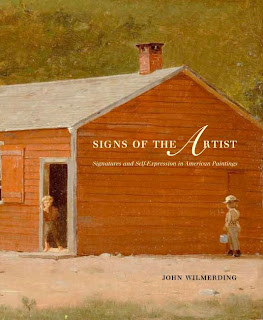Signing Up

Writing and documents are so pervasive in society that we see material expressions of them everywhere. John Wilmerding, Signs of the Artist: Signatures and Self-Expression in American Paintings (New Haven: Yale University Press, 2003) is a beautifully illustrated study of one means by which documents are represented (or, perhaps, that paintings serve as documents themselves). It is a book I stumbled across while on vacation recently in Maine.
Wilmerding commences by noting something of the general characteristics of signatures. “Signatures are unique,” and they “carry something of our individual personality” (p. ix). We use signatures to “activate passports and credit cards, validate driving licenses, authorize wills, and write checks to pay our bills” (p. ix). Wilmerding adds to these important functions of signatures, how artists use them: “For an artist a signature can acquire even more significance. On a work of art it confirms originality to a dealer or purchaser. . . . A buyer instinctively feels more confident if a signature is present, and its absence can often affect the market value considerably” (p. ix).
Signs of the Artist examines signatures on paintings from early modern European paintings through American paintings from the eighteenth-century through today and their use in still lifes, landscapes, genre paintings, Impressionism, realism, and Modernism. Wilmerding considers how artists use signatures in different parts of the painting, from the edges of tables to representations of documents, noting, “they both represent and stand in for the artist, situating the maker within the subject of the picture” (p. x).
This is an interesting addition to the study of the role of documents in American society.

